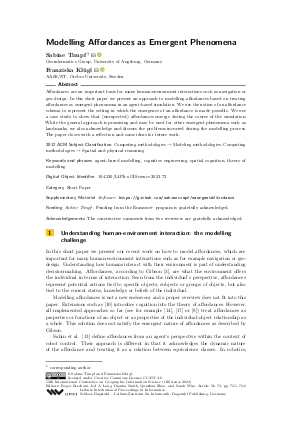Modelling Affordances as Emergent Phenomena (Short Paper)
Authors
Sabine Timpf  ,
Franziska Klügl
,
Franziska Klügl 
-
Part of:
Volume:
12th International Conference on Geographic Information Science (GIScience 2023)
Part of: Series: Leibniz International Proceedings in Informatics (LIPIcs)
Part of: Conference: International Conference on Geographic Information Science (GIScience) - License:
 Creative Commons Attribution 4.0 International license
Creative Commons Attribution 4.0 International license
- Publication Date: 2023-09-07
File

PDF
LIPIcs.GIScience.2023.72.pdf
- Filesize: 1.41 MB
- 6 pages
Document Identifiers
Subject Classification
ACM Subject Classification
- Computing methodologies → Modeling methodologies
- Computing methodologies → Spatial and physical reasoning
Keywords
- agent-based modelling
- cognitive engineering
- spatial cognition
- theory of modelling
Metrics
- Access Statistics
-
Total Accesses (updated on a weekly basis)
0Document
0Metadata
Abstract
Affordances are an important basis for many human-environment interactions such as navigation or geo-design. In this short paper we present an approach to modelling affordances based on treating affordances as emergent phenomena in an agent-based simulation. We use the notion of an affordance schema to represent the setting in which the emergence of an affordance is made possible. We use a case study to show that (unexpected) affordances emerge during the course of the simulation. While the general approach is promising and may be used for other emergent phenomena such as landmarks, we also acknowledge and discuss the problems incurred during the modelling process. The paper closes with a reflection and some ideas for future work.
Cite As Get BibTex
Sabine Timpf and Franziska Klügl. Modelling Affordances as Emergent Phenomena (Short Paper). In 12th International Conference on Geographic Information Science (GIScience 2023). Leibniz International Proceedings in Informatics (LIPIcs), Volume 277, pp. 72:1-72:6, Schloss Dagstuhl – Leibniz-Zentrum für Informatik (2023)
https://doi.org/10.4230/LIPIcs.GIScience.2023.72
BibTex
@InProceedings{timpf_et_al:LIPIcs.GIScience.2023.72,
author = {Timpf, Sabine and Kl\"{u}gl, Franziska},
title = {{Modelling Affordances as Emergent Phenomena}},
booktitle = {12th International Conference on Geographic Information Science (GIScience 2023)},
pages = {72:1--72:6},
series = {Leibniz International Proceedings in Informatics (LIPIcs)},
ISBN = {978-3-95977-288-4},
ISSN = {1868-8969},
year = {2023},
volume = {277},
editor = {Beecham, Roger and Long, Jed A. and Smith, Dianna and Zhao, Qunshan and Wise, Sarah},
publisher = {Schloss Dagstuhl -- Leibniz-Zentrum f{\"u}r Informatik},
address = {Dagstuhl, Germany},
URL = {https://drops.dagstuhl.de/entities/document/10.4230/LIPIcs.GIScience.2023.72},
URN = {urn:nbn:de:0030-drops-189672},
doi = {10.4230/LIPIcs.GIScience.2023.72},
annote = {Keywords: agent-based modelling, cognitive engineering, spatial cognition, theory of modelling}
}
Author Details
Funding
- Timpf, Sabine: Funding from the Erasmus+ program is gratefully acknowledged.
Acknowledgements
The constructive comments from two reviewers are gratefully acknowledged.
Supplementary Materials
References
-
Paola Ardón, Eric Pairet, Katrin S Lohan, Subramanian Ramamoorthy, and Ronald Petrick. Building affordance relations for robotic agents-a review. arXiv preprint arXiv:2105.06706, 2021.

-
Eric Bonabeau. Agent-based modeling: Methods and techniques for simulating human systems. PNAS, 99(3):7280-7287, 2002.

-
James J. Gibson. The Ecological Approach to Visual Perception. Houghton Mifflin, 1979.

-
Mark Johnson. The body in the mind: The bodily basis of meaning, imagination, and reason. University of Chicago Press, Chicago, IL, US, 1987.

- Franziska Klügl and Sabine Timpf. Approaching interactions in agent-based modelling with an affordance perspective. In Gita Sukthankar and Juan A. Rodríguez-Aguilar, editors, Autonomous Agents and Multiagent Systems - AAMAS 2017 Workshops, Best Papers, São Paulo, Brazil, May 8-12, 2017, Revised Selected Papers, volume 10642 of Lecture Notes in Computer Science, pages 222-238. Springer, 2017. URL: https://doi.org/10.1007/978-3-319-71682-4_14.
-
Franziska Klügl-Frohnmeyer and Sabine Timpf. Towards more explicit interaction modelling in agent-based simulation using affordance schemata. In Deutsche Jahrestagung für Künstliche Intelligenz, 2021.

-
C. M. Macal and M. J. North. Tutorial on agent-based modelling and simulation. Journal of Simulation, 4:151-162, 2010.

-
Raubal Martin. Human wayfinding in unfamiliar buildings: a simulation with a cognizing agent. Cognitive Processing, 2, January 2001.

-
Ulric Neisser. Cognition and Reality: Principles and Implications of Cognitive Psychology. Books in psychology. W. H. Freeman, 1976.

-
Martin Raubal. Ontology and epistemology for agent-based wayfinding simulation. Int. Journal of Geographical Information Science, 15:653-665, 2001.

- Erwan Renaudo, Philipp Zech, Raja Chatila, and Mehdi Khamassi. Editorial: Computational models of affordance for robotics. Frontiers in Neurorobotics, 16, 2022. URL: https://doi.org/10.3389/fnbot.2022.1045355.
-
David E. Rumelhart. Schemata: The building blocks of cognition. In R. J. Spiro, B. C. Bruce, and W. F. Brewer, editors, Theoretical Issues in Reading Comprehension, pages 33-58. Erlbaum, Hillsdale, NJ, 1980.

-
Erol Şahin, Maya Çakmak, Mehmet R. Doğar, Emre Uğur, and Göktürk Üçoluk. To afford or not to afford: A new formalism of affordances towards affordance-based robot control. Adaptive Behavior, 15(4):447-472, 2007.

-
Thomas A. Stoffregen. Affordances as properties of the animal environment system. Ecological Psychology, 15(2):115-134, 2003.

- Sabine Timpf. Appropriating places in public spaces: a multi-agent simulation. In Franziska Klügl, Sabine Timpf, and Ute Schmid, editors, Agent-based simulation: from cognitive modelling to engineering practice; workshop at the 31th German Conference on Artificial Intelligence, 2008. URL: http://ki.informatik.uni-wuerzburg.de/events/cog.abs/WS1-KI08-Proceedings.pdf.
- Sabine Timpf and Marie-Rose Degg. Agent-based modelling of people’s behaviour in public parks. In Jason Thompson, Minh Le Kieu, and Koen van Dam, editors, ABMUS2022: The 6th International Workshop on Agent-Based Modelling of Urban Systems, 2022. https://doi.org/10.6084/m9.figshare.19733800.
- Michael T. Turvey. Affordances and prospective control: An outline of the ontology. Ecological Psychology, 4(3):173-187, 1992. URL: https://doi.org/10.1207/s15326969eco0403_3.
- Rob Withagen, Harjo De Poel, Duarte Araujo, and Gert-Jan Pepping. Affordances can invite behavior: Reconsidering the relationship between affordances and agency. New Ideas in Psychology, 30:250-258, May 2012. URL: https://doi.org/10.1016/j.newideapsych.2011.12.003.
- Philipp Zech, Simon Haller, Safoura Rezapour Lakani, Barry Ridge, Emre Ugur, and Justus Piater. Computational models of affordance in robotics: a taxonomy and systematic classification. Adaptive Behavior, 25(5):235-271, 2017. URL: https://doi.org/10.1177/1059712317726357.
